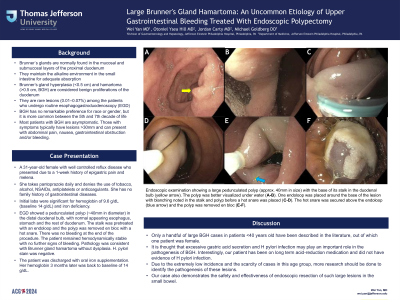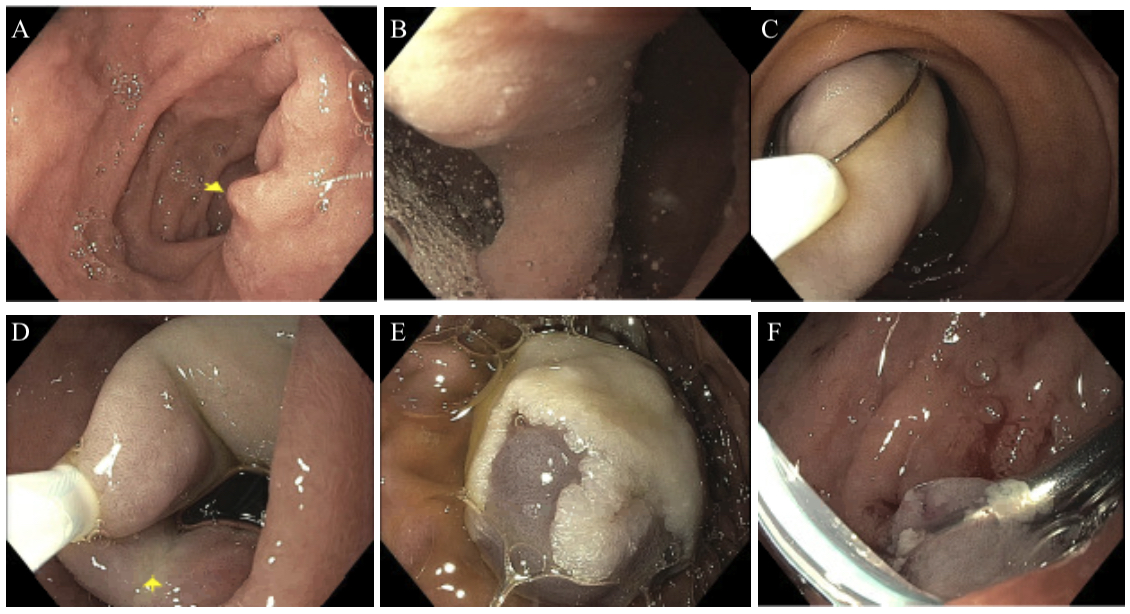Tuesday Poster Session
Category: Small Intestine
P4970 - Large Brunner's gland Hamartoma: An Uncommon Etiology of Upper Gastrointestinal Bleeding Treated With Endoscopic Polypectomy
Tuesday, October 29, 2024
10:30 AM - 4:00 PM ET
Location: Exhibit Hall E

Has Audio

Wei Yan, MD
Albert Einstein Medical Center
Philadelphia, PA
Presenting Author(s)
Wei Yan, MD, Otoniel Ysea Hill, MD, Jordan Carty, MD, Michael Goldberg, DO
Albert Einstein Medical Center, Philadelphia, PA
Introduction: Brunner´s glands are branched acinotubular glands found in the mucosal and submucosal layers of the proximal duodenum. Their main function is to maintain an alkaline environment in the small intestine for adequate absorption. Brunner’s gland hamartomas (BGH) are rare benign proliferations ( >0.5cm) with a frequency of 0.01–0.07% among those who undergo routine esophagogastroduodenoscopy (EGD). BGH is more common between the 5th-7th decade of life. While most patients with BGH are asymptomatic, those with symptoms typically have lesions >30mm and can present with abdominal pain, nausea, gastrointestinal obstruction and bleeding.
Case Description/Methods: A 31-year-old female with well controlled reflux disease who presented to the emergency department due to a 1-week history of epigastric pain and melena. She takes pantoprazole daily and denies the use of tobacco, alcohol, NSAIDs, antiplatelets or anticoagulants. She has no family history of gastrointestinal diseases. Initial labs were significant for hemoglobin of 9.6 g/dL (baseline 14 g/dL) and iron deficiency. She underwent an EGD and it showed a pedunculated polyp (~40mm in diameter) in the distal duodenal bulb, with normal appearing esophagus, stomach and the rest of duodenum. The stalk was pretreated with an endoloop and the polyp was removed en bloc with a hot snare. There was no bleeding at the end of the procedure. The patient remained hemodynamically stable with no further signs of bleeding. Pathology was consistent with Brunner gland hamartoma without dysplasia. H. pylori stain was negative. The patient was discharged with oral iron supplementation and daily pantoprazole. Her hemoglobin 3 months later was back to her baseline of 14 g/dL.
Discussion: We presented a case of a young female who developed upper gastrointestinal bleeding secondary to a large BHG. Only a handful of cases of patients < 40 years old have been described in the literature, out of which one single patient was a female. It is thought that excessive gastric acid secretion and H pylori infection may play an important role in the pathogenesis of BGH. Interestingly, our patient has been on long term acid-reduction medication and did not have evidence of H pylori infection. Due to the extremely low incidence and the scarcity of cases in this age group, more research should be done to identify the pathogenesis of these lesions. Our case also demonstrates the safety and effectiveness of endoscopic resection of such large lesions in the small bowel.

Disclosures:
Wei Yan, MD, Otoniel Ysea Hill, MD, Jordan Carty, MD, Michael Goldberg, DO. P4970 - Large Brunner's gland Hamartoma: An Uncommon Etiology of Upper Gastrointestinal Bleeding Treated With Endoscopic Polypectomy, ACG 2024 Annual Scientific Meeting Abstracts. Philadelphia, PA: American College of Gastroenterology.
Albert Einstein Medical Center, Philadelphia, PA
Introduction: Brunner´s glands are branched acinotubular glands found in the mucosal and submucosal layers of the proximal duodenum. Their main function is to maintain an alkaline environment in the small intestine for adequate absorption. Brunner’s gland hamartomas (BGH) are rare benign proliferations ( >0.5cm) with a frequency of 0.01–0.07% among those who undergo routine esophagogastroduodenoscopy (EGD). BGH is more common between the 5th-7th decade of life. While most patients with BGH are asymptomatic, those with symptoms typically have lesions >30mm and can present with abdominal pain, nausea, gastrointestinal obstruction and bleeding.
Case Description/Methods: A 31-year-old female with well controlled reflux disease who presented to the emergency department due to a 1-week history of epigastric pain and melena. She takes pantoprazole daily and denies the use of tobacco, alcohol, NSAIDs, antiplatelets or anticoagulants. She has no family history of gastrointestinal diseases. Initial labs were significant for hemoglobin of 9.6 g/dL (baseline 14 g/dL) and iron deficiency. She underwent an EGD and it showed a pedunculated polyp (~40mm in diameter) in the distal duodenal bulb, with normal appearing esophagus, stomach and the rest of duodenum. The stalk was pretreated with an endoloop and the polyp was removed en bloc with a hot snare. There was no bleeding at the end of the procedure. The patient remained hemodynamically stable with no further signs of bleeding. Pathology was consistent with Brunner gland hamartoma without dysplasia. H. pylori stain was negative. The patient was discharged with oral iron supplementation and daily pantoprazole. Her hemoglobin 3 months later was back to her baseline of 14 g/dL.
Discussion: We presented a case of a young female who developed upper gastrointestinal bleeding secondary to a large BHG. Only a handful of cases of patients < 40 years old have been described in the literature, out of which one single patient was a female. It is thought that excessive gastric acid secretion and H pylori infection may play an important role in the pathogenesis of BGH. Interestingly, our patient has been on long term acid-reduction medication and did not have evidence of H pylori infection. Due to the extremely low incidence and the scarcity of cases in this age group, more research should be done to identify the pathogenesis of these lesions. Our case also demonstrates the safety and effectiveness of endoscopic resection of such large lesions in the small bowel.

Figure: Figure A-F.
Endoscopic examination of the distal duodenal bulb showing a large, non-bleeding pedunculated polyp (~40mm in size). Stalk of the polyp (yellow arrow) (A). The polyp was submerged under water prior to Endoloop placement (B). A hot snare was used to remove the polyp (C-E). The Endoloop (yellow arrow) remained in place below the hot snare prior cutting (D). Polyp post-resection (E). Clip closure of resected stalk and Endoloop remains secure in place (F).
Endoscopic examination of the distal duodenal bulb showing a large, non-bleeding pedunculated polyp (~40mm in size). Stalk of the polyp (yellow arrow) (A). The polyp was submerged under water prior to Endoloop placement (B). A hot snare was used to remove the polyp (C-E). The Endoloop (yellow arrow) remained in place below the hot snare prior cutting (D). Polyp post-resection (E). Clip closure of resected stalk and Endoloop remains secure in place (F).
Disclosures:
Wei Yan indicated no relevant financial relationships.
Otoniel Ysea Hill indicated no relevant financial relationships.
Jordan Carty indicated no relevant financial relationships.
Michael Goldberg indicated no relevant financial relationships.
Wei Yan, MD, Otoniel Ysea Hill, MD, Jordan Carty, MD, Michael Goldberg, DO. P4970 - Large Brunner's gland Hamartoma: An Uncommon Etiology of Upper Gastrointestinal Bleeding Treated With Endoscopic Polypectomy, ACG 2024 Annual Scientific Meeting Abstracts. Philadelphia, PA: American College of Gastroenterology.
